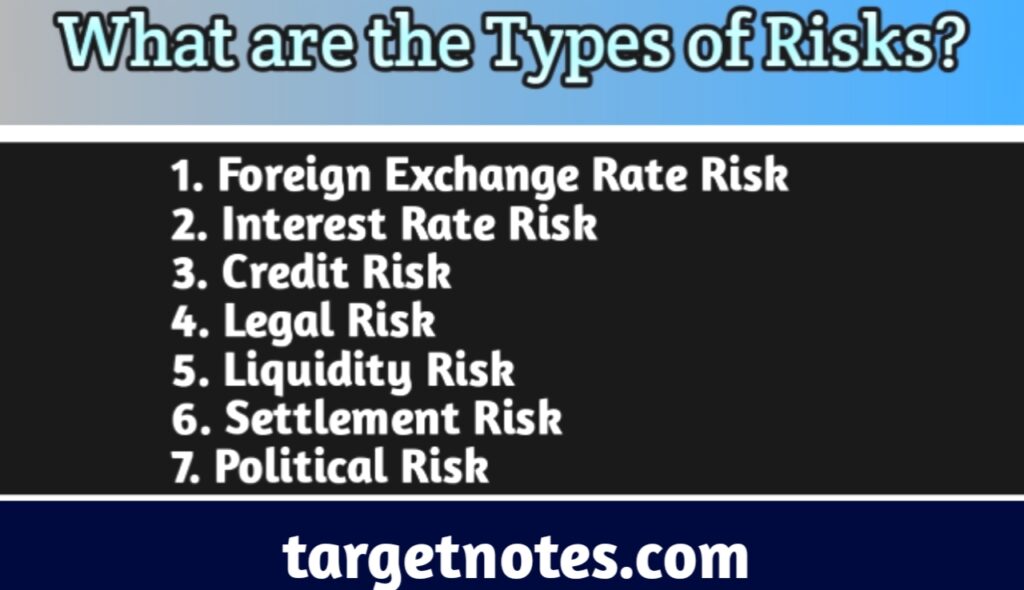
What are the types of Risks. Explain in detail?
What are the types of Risks. Explain in detail?
The value of firm’s assets, liabilities, operating incomes, operating expenses, and other abnormal incomes, expenses differ from expected one clue to changes in many economic and financial variables like exchange rates, interest rates, inflation rates etc.
The appreciation of a local currency results in decreasing the local currency value with respect to exports receivable denominated in foreign currency. Such appreciation or depreciation of local currency makes effect on the cash flow of domestic currency due to the transactions’ exposure of merchandise and non-merchandise exports and imports.
Exposure is a measure of the sensitivity of the value of a financial item (cash flow, assets, liability etc.) to changes in variables like exchange rates, etc., while risk is a measure of the variability of the value of the financial item.
A firm always encounters a number of risks during the course of business, i.e. political instability, technical obsolescence, availability of skilled labour, extent of trade unionism, infrastructural bottlenecks and financial risks.
Generally risks which a firm has been categorized as:
- Foreign exchange rate risk
- Interest rate risk
- Credit risk
- Legal risk
- Liquidity risk
- Settlement risk
- Political risk
1. Foreign Exchange Rate Risk:
The variance or changes of the real domestic currency value of assets, liabilities or operating income on account of unanticipated changes in exchange rates referred as Foreign Exchange Risk. This risk relates to the uncertainty attached to the exchange rates between the two currencies.
If an Indian businessman borrows some amount viz. dollars and has to repay the loan in dollars only over a period of time, then he is said to be exposed to the foreign exchange rate risk during the currency of loan.
Thus, if the dollar becomes stronger (costly) vis-a-vis rupees (cheap) or depreciated during the period then the businessman has to repay the loan in terms of more rupees than the rupees he obtained by way of loan. The extra rupees which he pays are not due to an increase of interest rates, but because of the unfavourable foreign exchange rate.
On the contrary, he gains if the dollar weakens vis-a-vis rupee because of favourable exchange rate. Anyway, the businessman would like to protect his business from unfavourable exchange rate by adopting a number of hedging techniques and would like to optimise his gains in case of favourable exchange rate situation. This mechanism, in short, is known as Foreign Exchange Risk Management.
Indian business was not very much exposed to this risk as the exchange rate in India operated in RBI controlled regime. However, with the advent of the budget for 1993-94, a new era was ushered in by opening up Indian economy to the International market.
The various steps taken for encouraging globalization have made the Indian business vulnerable to foreign exchange rate risk. Hence, exchange rate risk exposure is considered to be an important factor while conducting business in India.
The types of foreign exchange risks and exposure are:
- Transaction exposure
- Translation exposure
- Economic exposure
- Operating exposure
2. Interest Rate Risk: The fluctuations in interest rates over a period of time change the cash flow need of a firm, for interest payment. The rate of interest is decided and agreed among parties (i.e. lender and borrower) at the time of sanctioning of debt.
The interest rate may be constant or may be related to some other variable or benchmark. If it is constant, it is known as, Fixed Interest Rate Debt Instrument’ (FXR). If the rate is linked to any other variable or benchmark say LIBOR (London Inter-Bank Offer Rate) then known as Floating Interest Rate Debt Instrument (FIR).
Interest Rate Exposure and Risk: Interest rate uncertainty exposes a firm to the following types of risks. Borrowings on floating rate bring uncertainty relating to future interest payments, for the firm. The floating rate makes borrowing cost of capital unknown.
The problem is that there is a rise of variation in interest rate risk for the firm due to the fluctuating or floating rate clause in loan agreement. Hence, firm management not sure about the interest payment they have to make whenever interest amount is payable to financial institutions or lenders of the funds. Borrowings on fixed rate basis results in risk if future periods interest rates may come down, and the firm has to continue with a heavy burden on debt servicing.
In the Indian environment, the management of interest rate risks has been a comparatively new concern. The behaviour of interest rates during the period of 2003-2008 has upset the cost and return calculations of many industries.
The exchange rate fluctuation in the South East Asian Countries or the nosedive (sudden plunge or changes) of rupee in terms of dollars shows the extreme sensitivity of exchange rates, and in turn the extent to which the firm’s exposures affected.
Interest rates in India were regulated and controlled by the dictates of the Reserve Bank of India. This ensured a stability of interest rate mechanism and the Indian business was not very much bothered about them. However, with changes being brought out by the Government and Reserve Bank of India, it is quite clear that interest rates will henceforth be market driven.
3. Credit Risk: A credit risk is the risk, in a transaction, of counter party of the transaction failing to meet its obligation towards the transaction. This risk is present in all trade and commerce transactions, thus it also includes the transactions relating to foreign trade and foreign exchange.
4. Legal Risk: The risk arising due to legal enforceability of a contract or a transaction is known as legal risk. The contract is normally unenforceable due to pending, or newly created, political and legal issues between the two trading countries. The various legal taxes, controls, regulations, exchange and trade controls, controls on financial transactions, controls on tariff, and quotas system, are risks factors or elements in foreign trade and finance flows.
5. Liquidity Risk: If the markets turn illiquid or the positions in market are such that cannot be liquidated, except huge price concession, the resultant risk is known as liquidity risk. It can also be termed that the risks which, though directly or indirectly, affect the liquidity and in turn long term solvency of the parties in the market, is known as liquidity risk.
The international financial system failed to support the increasing demands of expanding trade and finance due to lack of enough resources, efficient and quick actions of surveillance on capital flows and inadequate liquidity to meet emerging crisis situations.
6. Settlement Risk: This is the risk of counterparty failing during settlement, because of time difference in the markets in which cash flows the two currencies have to be paid and received viz. settled.
Settlement risk depends on the various risks like risk of the borrowing company’s ability to meet its debt service obligation in time, represented by the risk of its business, financial risk, market risk, labour problems, restrictions on dividend distribution, fluctuations in profits and a host of other company related problems. Unanticipated depreciation of a country’s currency might hurt a company which is net importer but it may benefit exporter.
7. Political Risk: Political Risk is the risk that results from political changes or instability in a country. Such variability or changes always result into some kind of changes in the monetary. fiscal, legal, and other policies of the country facing the changes.
It has adverse impact on the working of the financial and commercial operation carried out by the country with the globe, and. also of foreign enterprise located in host country. When a factor of instability is found with a country, such kind of risk crop up, and affect the foreign trade and exchange of the country adversely. The political risk results in to uncertainty over property rights and protection of, wealth.
- Meaning and Types of commercial risks
- How can we minimize foreign trade risks?
- What are Arbitrage operations?
- Difference between Spot Market and Forward Market
- What is spot exchange?
- Agency agreement: Meaning, Features and Advantages
- Functions of Foreign Exchange markets
- structure of Foreign exchange markets
- Stability of Exchange Rate- Facts, significance, method, theories & warning
- Main Items Debit and Credit sides of the Balance of Payment
- Differences between Educational Administration and General Administration
- General Administration and Educational Administration
- Nature of Educational Administration
- Scope of School Administration
- Definitions of Educational Administration by Different Scholars
- Definitions of Educational Administration by Different Scholars
- Meaning of Educational Administration
- Principles of School Organisation and Administration
- Aims and Objectives of School Organisation
- School Organisation | Meaning of School Organisation | Meaning of School |Meaning of Organisation
Disclaimer




